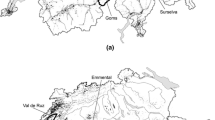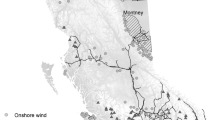Abstract
The United States energy industry is transforming with the rapid development of alternative energy sources and technological advancements in fossil fuels. Two major changes include the growth of wind turbines and unconventional oil and gas. We measured land-use impacts and associated ecosystem services costs of unconventional gas and wind energy development within the Anadarko Basin of the Oklahoma Woodford Shale, an area that has experienced large increases in both energy sectors. Unconventional gas wells developed three times as much land compared to wind turbines (on a per unit basis), resulting in higher ecosystem services costs for gas. Gas wells had higher impacts on intensive agricultural lands (i.e., row crops) compared to wind turbines that had higher impacts on natural grasslands/pastures. Because wind turbines produced on average less energy compared to gas wells, the average land-use-related ecosystem cost per gigajoule of energy produced was almost the same. Our results demonstrate that both unconventional gas and wind energy have substantial impacts on land use, which likely affect wildlife populations and land-use-related ecosystem services. Although wind energy does not have the associated greenhouse gas emissions, we suggest that the direct impacts on ecosystems in terms of land use are similar to unconventional fossil fuels. Considering the expected rapid global expansion of these two forms of energy production, many ecosystems are likely to be at risk.


Similar content being viewed by others
References
Agarwal RG, Gardner DC, Kleinsteiber SW, Fussell DD (1998) Analyzing well production data using combined type curve and decline curve analysis concepts. In: Society of Petroleum Engineers Annual Technical Conference and Exhibition, New Orleans, Louisiana, 27–30 September 1998
Alig RJ, Butler BJ (2004) Area changes for forest cover types in the United States, 1952 to 1997, with projections to 2050. General Technical Report PNW-GTR-613. United States Department of Agriculture, Forest Service, Pacific Northwest Research Station, Portland, Oregon
Allred BW, Smith WK, Twidwell D, Haggerty JH, Running SW, Naugle DE, Fuhlendorf SD (2015) Ecosystem services lost to oil and gas in North America. Science 348:401–402
Askins RA, Chávez-Ramírez F, Dale BC, Haas CA, Herkert JR, Knopf FL, Vickery PD (2007) Conservation of grassland birds in North America: understanding ecological processes in different regions. Ornithol Monogr 64:1–46
Asner GP, Elmore AJ, Olander LP, Martin RE, Harris AT (2004) Grazing systems, ecosystem responses, and global change. Annu Rev Environ Resour 29:261–299
Baihly JD, Altman RM, Malpani R, Luo F (2010) Shale gas production decline trend comparison over time and basins. In: Society for Petroleum Engineers Annual Technical Conference and Exhibition, Florence, Italy
Baerwald EF, D’Amours GH, Klug BJ, Barclay RM (2008) Barotrauma is a significant cause of bat fatalities at wind turbines. Curr Biol 18:R695–R696
Barrios L, Rodriguez A (2004) Behavioural and environmental correlates of soaring‐bird mortality at on‐shore wind turbines. J Appl Ecol 41:72–81
Blehert DS, Hicks AC, Behr M, Meteyer CU, Berlowski-Zier BM, Buckles EL, Coleman JT, Darling SR, Gargas A, Niver R, Okoniewski JC (2009) Bat white-nose syndrome: an emerging fungal pathogen? Science 323:227–227
Colby D, Dobie R, Leventhall G, Lipscomb DM, McCunney RJ, Seilo MT, Sondergaard B (2009) Wind turbine sound and health effects: An expert panel review. Canadian Wind Energy Association, Ottowa, Ontario, Canada
Costanza R, de Groot R, Sutton P, van der Ploeg S, Anderson SJ, Kubiszewski I, Farber S, Turner RK (2014) Changes in the global value of ecosystem services. Glob Environ Chang 26:152–158
de Groot R, Fisher B, Christie M, Aronson J, Braat L, Gowdy J, Haines-Young R, Maltby E, Neuville A, Polasky S, Portela R, Ring I (2010) Integrating the ecological and economic dimensions in biodiversity and ecosystem service valuation. In: Kumar P (ed) The economics of ecosystems and biodiversity: ecological and economic foundations. Earthscan, London, pp 9–39
de Groot R, Brander L, Van Der Ploeg S, Costanza R, Bernard F, Braat L, Christie M, Crossman N, Ghermandi A, Hein L, Hussain S (2012) Global estimates of the value of ecosystems and their services in monetary units. Ecosyst Serv 1:50–61
Dramstad W, Olson JD, Forman RT (1996) Landscape ecology principles in landscape architecture and land-use planning. Island Press, Washington
Drummond MA, Loveland TR (2010) Land use pressure and a transition to forest-cover loss in the eastern United States. BioScience 60:286–298
EIA (Energy Information Administration) (2014) Annual energy outlook 2014: preliminary reference case results for oil and natural gas. http://www.eia.gov/forecasts/aeo/pdf/0383(2014).pdf. Accessed 19 Oct 2016
EIA (Energy Information Administration) (2015) Annual energy outlook 2015: with projections to 2040. http://www.eia.gov/forecasts/aeo/pdf/0383(2015).pdf. Accessed 19 Oct 2016
EIA (Energy Information Administration) (2016a) Preliminary Monthly Electric Generator Inventory. https://www.eia.gov/electricity/data/eia860m/. Accessed 19 Oct 2016
EIA (Energy Information Administration) (2016b) EIA electricity data browser. http://www.eia.gov/electricity/data/browser/. Accessed 19 Oct 2016
EIA (Energy Information Administration) (2016c) Electric Power Monthly. http://www.eia.gov/electricity/monthly/. Accessed 19 Oct 2016
Ellsworth WL (2013) Injection-induced earthquakes. Science 341:1225942
Fitzgerald T (2010) Evaluating split estates in oil and gas leasing. Land Econ 86:294–312
Grieser WV (2011) Oklahoma Woodford Shale: completion trends and production outcomes from three basins. In: Society of Petroleum Engineers Production and Operations Symposium, Oklahoma City, Oklahoma, 27–29 March
Guo K, Zhang B, Aleklett K, Höök M (2016) Production patterns of Eagle Ford shale gas: decline curve analysis using 1084 wells. Sustainability 8:973
Herbert GJ, Iniyan S, Sreevalsan E, Rajapandian S (2007) A review of wind energy technologies. Renew Sustain Energy Rev 11:1117–1145
Hitaj C, Boslett A, Weber JG (2014) Shale development and agriculture. Choices 29:1–7
Hoen B, Wiser R, Cappers P, Thayer M, Sethi G (2011) Wind energy facilities and residential properties: the effect of proximity and view on sales prices. J Real Estate Res 33:279–316
Hughes JD (2013) Energy: a reality check on the shale revolution. Nature 494:307–308
Hughes JD (2014) Drilling deeper: a reality check on US government forecasts for a lasting tight oil & shale gas boom. Post Carbon Institute, Santa Rosa, California
IEA (International Energy Agency) (2016) World energy statistics 2016. Organization for Economic Co-operation and Development, Paris
Jackson RB, Vengosh A, Carey JW, Davies RJ, Darrah TH, O’Sullivan F, Pétron G (2014) The environmental costs and benefits of fracking. Ann Rev Environ Resour 39:327–362
Jacquet JB (2012) Landowner attitudes toward natural gas and wind farm development in northern Pennsylvania. Energ Policy 50:677–688
Javeline D, Hellmann JJ, Cornejo RC, Shufeldt G (2013) Expert opinion on climate change and threats to biodiversity. BioScience 63:666–673
Jones NF, Pejchar L, Kiesecker JM (2015) The energy footprint: how oil, natural gas, and wind energy affect land for biodiversity and the flow of ecosystem services. BioScience 65:290–301
Johnson N (2010) Pennsylvania energy impact assessment. The Nature Conservancy, Arlington, Virginia
Kansas Energy Information Network (2016) Oklahoma Wind Farms. http://kansasenergy.org/wind_projects_OK.htm. Accessed 05 Oct 2016
Kunz TH, Arnett EB, Erickson WP, Hoar AR, Johnson GD, Larkin RP, Strickland MD, Thresher RW, Tuttle MD (2007) Ecological impacts of wind energy development on bats: questions, research needs, and hypotheses. Front Ecol Environ 5:315–324
Laiolo P, Tella JL (2006) Fate of unproductive and unattractive habitats: recent changes in Iberian steppes and their effects on endangered avifauna. Environ Conser 33:223–232
Leung DY, Yang Y (2012) Wind energy development and its environmental impact: a review. Renew Sust Ener Rev 16:1031–1039
McDonald RI, Fargione J, Kiesecker J, Miller WM, Powell J (2009) Energy sprawl or energy efficiency: climate policy impacts on natural habitat for the United States of America. PLoS ONE 4:e6802
Mitchell AL, Casman EA (2011) Economic incentives and regulatory framework for shale gas well site reclamation in Pennsylvania. Environ Sci Technol 45:9506–9514
Moran MD, Cox AB, Wells RL, Benichou CC, McClung MR (2015) Habitat loss and modification due to gas development in the Fayetteville shale. Environ Manag 55:1276–1284
Moran MD, Taylor NT, Mullins TF, Sardar SS, McClung MR (2017) Land-use ecosystem services costs of unconventional oil and gas in the United States. Front Ecol Enviro 15:237–242
Oklahoma Corporation Commission, Oil and Gas Division (2016) Oil and gas data files. http://www.occeweb.com/og/ogdatafiles2.htm. Accessed 05 Oct 2016
Oklahoma Department of Transportation (2010) 2010–2035 Oklahoma Long Range Transportation Plan. http://www.odot.org/p-r-div/lrp_2010-2035/lrp_2010-2035_without-maps.pdf. Accessed 25 Oct 2016
Oklahoma Forestry Services (2007) The ecoregions of Oklahoma. http://www.forestry.ok.gov/Websites/forestry/Images/Ecoregions.pdf. Accessed 05 Oct 2016
Preston TM, Kim K (2016) Land cover changes associated with recent energy development in the Williston Basin; Northern Great Plains, USA. Sci Total Environ 566:1511–1518
Pruett CL, Patten MA, Wolfe DH (2009) Avoidance behavior by prairie grouse: implications for development of wind energy. Conserv Biol 23:1253–1259
Reinsalu E, Aarna I (2015) About technical terms of oil shale and shale oil. Oil Shale 32:291–292
Rosenberg AA, Phartiyal P, Goldman G, Branscomb LM (2014) Exposing fracking to sunlight. Issues Sci Technol 31:74
Saidur R, Islam MR, Rahim NA, Solangi KH (2010) A review on global wind energy policy. Renew Sust Energ Rev 14:1744–1762
Şahin AD (2004) Progress and recent trends in wind energy. Prog Energ Combust Sci 30:501–543
Scarrow RM, Crenshaw EM (2015) The ecology of energy use: using the POET model to analyze consumption and intensity across nations 1970–2000. Popul Environ 36:311–330
Shonkoff SB, Hays J, Finkel ML (2013) Environmental public health dimensions of shale and tight gas development. Environ Health Perspect 122:787
Smallwood KS (2007) Estimating wind turbine‐caused bird mortality. J Wildl Manag 71:2781–2791
Staffell I, Green R (2014) How does wind farm performance decline with age? Renew Energ 66:775–786
Swengel SR, Schlicht D, Olsen F, Swengel AB (2011) Declines of prairie butterflies in the midwestern USA. J Insect Conserv 15:327–339
Trainor AM, McDonald RI, Fargione J (2016) Energy sprawl is the largest driver of land use change in United States. PLoS ONE 11:e0162269
U.S. Geological Survey Oil and Gas Assessment Team (2012) Variability of distributions of well-scale estimated ultimate recovery for continuous (unconventional) oil and gas resources in the United States: US Geological Survey Open-File Report 2012–1118, 18 p. http://pubs.usgs.gov/of/2012/1118/OF12-1118.pdf. Accessed 26 Oct 2016
Wang Q, Chen X, Jha AN, Rogers H (2014) Natural gas from shale formation–the evolution, evidences and challenges of shale gas revolution in United States. Renew Sust Energ Rev 30:1–28
Weber JG, Brown JP, Pender J (2013) Rural wealth creation and emerging energy industries: lease and royalty payments to farm households and businesses. Federal Reserve Bank of Kansas City Working Paper 13-07
Wiser R, Bolinger M (2014) 2014 wind technologies market report. US Department of Energy, Washington
Wiser R, Bolinger M (2015) 2015 wind technologies market report. US Department of Energy, Washington
Acknowledgements
We wish to thank the Hendrix College Odyssey Program for support of this project. Two anonymous reviewers provided valuable feedback that greatly improved the manuscript.
Author information
Authors and Affiliations
Corresponding author
Ethics declarations
Conflict of Interest
The authors declare that they have no conflict of interest.
Ethical Standards
This study complies with all US laws. All appropriate approvals were obtained for the research. No animals were utilized.
Rights and permissions
About this article
Cite this article
Davis, K.M., Nguyen, M.N., McClung, M.R. et al. A Comparison of the Impacts of Wind Energy and Unconventional Gas Development on Land-use and Ecosystem Services: An Example from the Anadarko Basin of Oklahoma, USA. Environmental Management 61, 796–804 (2018). https://doi.org/10.1007/s00267-018-1010-0
Received:
Accepted:
Published:
Issue Date:
DOI: https://doi.org/10.1007/s00267-018-1010-0




